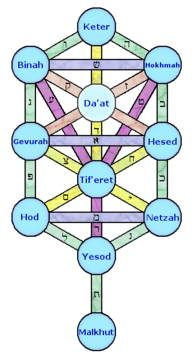Malkuth
| The Sephirot in Jewish Kabbalah | ||
|---|---|---|

| ||
| Category:Sephirot | ||
Malkuth or Malchut ("kingdom"; ملكوت ;מלכות), or Shekhinah, is the tenth of the sephirot in the Kabbalistic Tree of Life. It sits at the bottom of the Tree, below Yesod. This sephirah has as a symbol the Bride which relates to the sphere of Tipheret, symbolized by the Bridegroom.
Unlike the other nine sephirot, it is an attribute of God which does not emanate from God directly. Rather it emanates from God's creation—when that creation reflects and evinces God's glory from within itself.[1]
Hermetic and Christian Kabbalah
Malkuth means Kingdom. It is associated with the realm of matter/earth and relates to the physical world, the planets and the solar system. It is important not to think of this sephirah as merely "unspiritual", for even though it is the emanation furthest from the divine source, it is still on the Tree of Life. As the receiving sphere of all the other sephirot above it, Malkuth gives tangible form to the other emanations. It is like the negative node of an electrical circuit. The divine energy comes down and finds its expression in this plane, and our purpose as human beings is to bring that energy back around the circuit again and up the Tree.
Some occultists have also likened Malkuth to a cosmic filter, which lies above the world of the Qliphoth, or the Tree of Death, the world of chaos which is constructed from the imbalance of the original sephirot in the Tree of Life. For this reason it is associated with the feet and anus of the human body, the feet connecting the body to Earth, and the anus being the body's "filter" through which waste is excreted, just as Malkuth excretes unbalanced energy into the Qliphoth. Another way to understand this is that when one is sitting, as in a meditative state, it is the anus that makes physical contact with the Earth, whereas when one is standing or walking, it is the feet that come in contact with the Earth, or Malkuth.
Malkuth is also associated with the world of Assiah, the material plane, and the lowest of the Four Worlds of Kabbalah. Because of this relation to Assiah, it is also related to the Suit of Pentacles or Coins in the Tarot. In the modern card set, this relates to the Suit of Diamonds and symbolizes material wealth, or the treasures found in the physical world. Through Assiah, Malkuth is also related to the four Page cards in the Tarot as well. These are seen as the Jacks of the modern deck. Because it is directly associated with Assiah, Malkuth also represents the second He (ה) in the tetragrammaton (יהוה). There is also a connection to the tenth card of each suit in Tarot. The element of Malkuth is Earth.
The name of God is Adonai Melekh or Adon ha-Arets. These exist in the highest world, Atziluth. In the world of Briah, where the archangels reside, the archangel of this sphere is Sandalphon. In the world of Yetzirah, the Ishim (souls of fire) is the Angelic order. In Assiah, the planetary or astrological correspondence with Malkuth is the Earth. In the outer shell of its Sephiroth in Assiah, the Qliphah of Malkuth is Lilith.
Symbols associated with this sphere are a Bride (a young woman on a throne with a veil over her face) and a double cubed altar. Where Binah is known as the Superior Mother, this sphere is referred to as the Inferior Mother. It is also referred to as the bride of Microprosopos, where Macroprosopos is Kether.[2]
From a Christian viewpoint this sphere is important since Jesus preached that people should "seek first the Kingdom of God".
In some systems, it is equated with Da'at, knowledge, the invisible sephirah.
In comparing with Eastern systems, Malkuth is a very similar archetypal idea to that of the Muladhara chakra. In this manner, Malkuth is again associated with the anus, although technically the Muladhara is located in the sacram bone. In Shakta tantra, which is also associated with the Earth, the plane in which karma is expressed.
Although Malkuth is seen as the lowest Sefirah on the tree of life, it also contains within it the potential to reach the highest. This is exemplified in the Hermetic maxim 'As above so below'.
References
- ↑ Shimon Leiberman, Malchut: The Kingdom Within
- ↑ Dion Fortune, The Mystical Qabalah, Antiquarian Press, Northamptonshire, 1987, p162